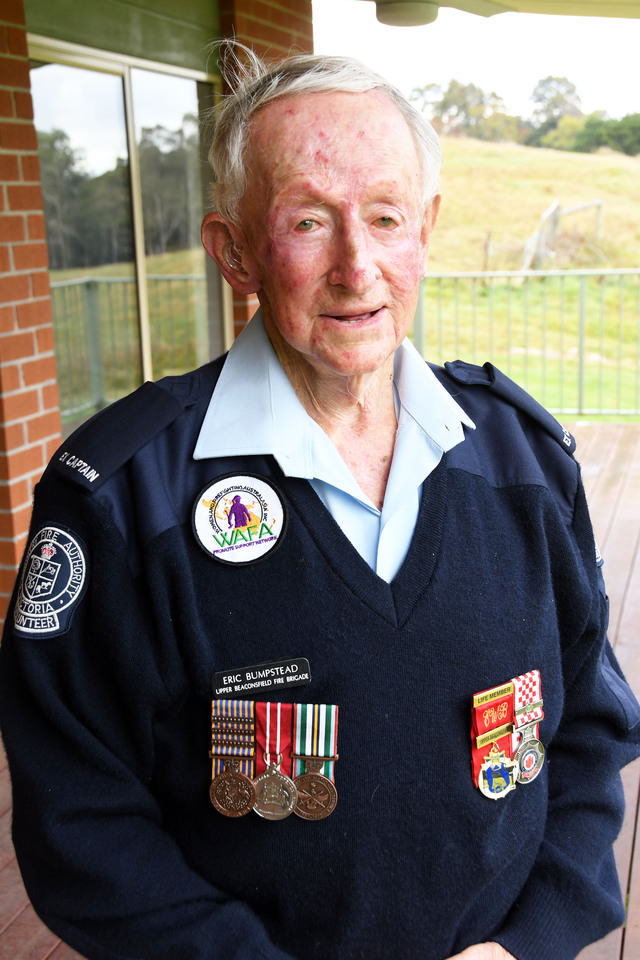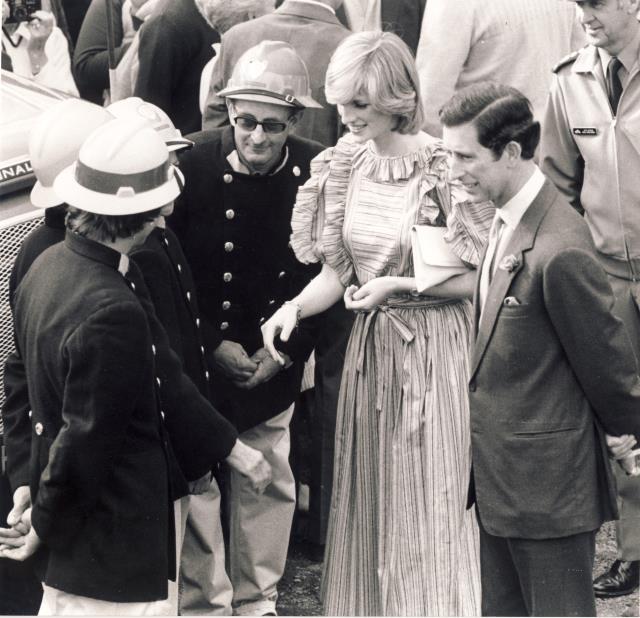By Matthew Sims
Guys Hill resident Eric Bumpstead has always had a passion for supporting his community through hard times, from beating out his first fire with his father with a bunch of branches in 1944 to leading the Upper Beaconsfield Fire Brigade through the devastating losses of the 1983 Ash Wednesday bushfires.
The 91-year-old has received a Medal of the Order of Australia (OAM) in this year’s King’s Birthday honours.
Born on November 1, 1932 at the Pakenham Bush Nursing Hospital, he went to school at the old Pakenham State School, followed by Oakleigh Technical School.
Eric said when he grew up in Pakenham, there was no water running to the house and the ‘night soil’ was collected regularly.
He married his wife Joyce in 1954, with the pair recently celebrating their 70th wedding anniversary.
Eric said he met Joyce at a debutante ball in Berwick.
“In those days, that was the way young people met,” she said.
“She always worked with her father on the farm as a farm girl.”
The pair helped their Guys Hill property flourish as an orchard, with the pair running a stall selling apples and potatoes for about 30 years.
Eric said he encountered his first fire in 1944, while helping his father on the horse and cart delivering meat for the Pakenham Butchery.
“We got some twigs and beat that one out,” he said.
However, it was not until 1957 that Eric decided to join the Upper Beaconsfield Fire Brigade.
“I was home all the time,” he said.
“They were always short on crew members.”
Eric served as the brigade captain for 24 years from 1973 to 1997 and remained a member of the brigade until 2018.
He received a 65-year service medal from the CFA in 2023, as well as the Stan Henwood Award from Cardinia Council in 2018 and was the Pakenham Shire Citizen of the Year in 1984.
He also received a medal from Women and Firefighting Australasia for being one of the first brigades to welcome women firefighters in 1981.
“Blokes were against women in the fire brigade,” he said.
“We had a shortage of manpower.
“One of the women came up to me and asked to become a firefighter and I said yes.”
Eric said the first group of women inducted into the brigade consisted of seven volunteers, later dubbed ‘Eric’s Angels’, a reference to the television show ‘Charlie’s Angels’.
“We used to train the blokes on a Wednesday and the women on Thursdays,” he said.
Eric said the women had to overcome one of the largest fires the country had ever seen, in the 1983 Ash Wednesday bushfires.
“That was the first fire they were turned out to,” he said.
“They performed very well.
“They proved their worth on Ash Wednesday.”
On 16 February 1983, the Upper Beaconsfield community was left devastated after the Ash Wednesday bushfires ravaged the town.
The event claimed 180 homes and 21 lives, including 12 firefighters from two crews from the Narre Warren Rural Fire Brigade and the Panton Hill Rural Fire Brigade and nine residents.
It remains a day that will stay with Mr Bumpstead for the rest of his life.
“Upper Beaconsfield was hit very hard with Ash Wednesday,” he said.
“You had a 16-kilometre firewall approaching.
“It was a pretty hopeless thing.”
Eric said with communication lines down, it was hard to know where to focus their efforts.
“When the wind changed, the temperature didn’t drop,” he said.
“There was going to be a change, that’s all we knew.
“The fire was so hot it used up all the oxygen.”
Eric said it was still hard to think about the loss of the 12 firefighters.
“Those two trucks left the scene and they weren’t found until the next day,” he said.
“That was the biggest loss the CFA had ever seen.
“We were pretty much on our own.”
Eric said beyond the recovery, the town was still anxious about the devastating effects of fire.
“It was very stressful for me,” he said.
“The whole community was traumatised.
“You had to go to every call that they made.”
In the aftermath of the fires, the Upper Beaconsfield and nearby communities including Cockatoo, the area was left devastated, needing a light at the end of the tunnel.
Excitement arrived in the area in the form of a visit from then Prince Charles and Princess Diana.
Eric put his hand up to be one of the chaperone for the pair in greeting and speaking with affected homeowners and the loved ones of those killed in the fire.
“We were lined up along the road in Cockatoo,” he said.
“It was a bit of a boost for them.”
Eric remembered moving the crowd in front of a muddy puddle to prevent Charles and Diana having to walk through the muddy puddle, causing a pack of British journalists and other members of the foreign press to yell at locals to get out of the way of the Prince and Princess for photo opportunities.
“I was like the man at Tiananmen Square,” he said.
“I went to the press and I said ‘This is their day’.”
Eric was also one of the main advocates to honour those who lost their lives in the fire in a permanent cairn and memorial park in the town.
“A lot of brigade members still visit every year,” he said.
Eric was also a founding member and former president of the Upper Beaconsfield Men’s Shed, a former member of the Salisbury Park Management committee and a former committee member of the Upper Beaconsfield Association.
Eric has lived on his property in Guys Hill for the past 71 years, enjoying caring to the orchard until removing it recently.
He said he has always loved putting his hand up to support the community.
“I’ve always been community minded,” Eric said.
“To make a good community, you’ve got to do something about it and help it.
“There’s not the community spirit around that there used to be.”
Eric said it was “an honour” to be recognised among other Australian icons and community supporters, but he received the honour on behalf of others within the community who had supported him throughout the years.
“I don’t do things for medals,” he said.
“It’s never a one-man thing.”








